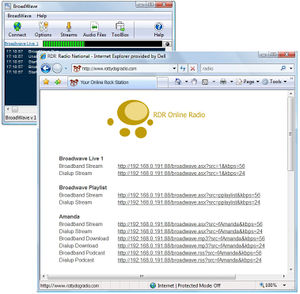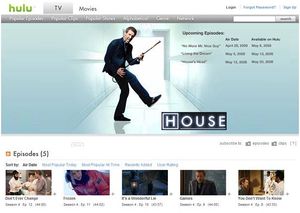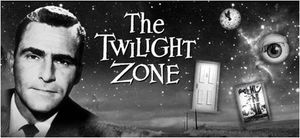Web TV
Fall 2008 T 30 Group 3 Travis Westover Keshia Cheung Dahye Kwon
Contents
The Group
Group 3 Tutorial 30 Members: Travis Westover, Keshia Cheung, Dahye Kwon, Slava Nartakhov
Initial Project Statement
This project examines a new and emerging technology, Web TV. Web TV is an exciting new medium, with much growth potential. We argue that television on the web is becoming more popular and is a very convenient way for people to access their favorite t.v. shows.
What is streaming and what are the advantages
Streaming is a technology that allows users to instantaneously access audio, video and other multimedia contents over the internet. Streaming has three key advantages over the traditional method of downloading multimedia content. First, streaming allows users to access multimedia content without delay. Second, streaming saves the user from downloading the multimedia content onto their storage media, which saves the users from wasting their storage media space. Lastly, streaming allows the owners of the multimedia content to better protect the proprietary rights attached to such multimedia content.
How you would view multimedia content on the internet
When you view multimedia content on the internet, the following occurs in the background. Your computer software sends a signal to a content server. The content server in turn sends a signal to a media server. The media server then sends the data containing the multimedia content to software on the user's computer, which in turn "decodes" the data so that it can be enjoyed by the user. Typically, multimedia content require large amounts of data. This is not surprising considering that multimedia content, such as a video, consists of thousands of pictures along with sound and data to allow the pictures to be viewed as "motion" by the human eye. However, a typical internet user has a limited amount of bandwidth. In other words, there is a speed restriction on how fast data can be downloaded. This is why most multimedia content is sent to the user's computers in a compressed format. While this results in media content with a lower quality, compression allows the user to obtain data in less time. Without compression of data, most users would not be able to enjoy streaming of multimedia content due to speed restrictions that exist over the internet.
Two types of streaming
Many people use the term "streaming" loosely. A common view is that any type of media that is instantly accessible over the internet is considered streaming. However, there are two types of so called "streaming". One is called a "true streaming" and the other is called a "progressive downloading". Only true streaming has all three advantages discussed in the preceding paragraph. Before we can discuss the differences between a progressive downloading and a true streaming, we need to understand the basics of how media content is accessed by a user over the internet.
Progressive downloading
Progressive downloading, as the name suggests, is simply a way to view the data as the downloading is occurring. Most forms of streaming media on the internet, such as Real Media, Quicktime and Windows Media uses progressive downloading to "stream" the multimedia content to a user. The type of formatting used by these programs allows the software to output multimedia content on the user's monitor as each segment of data is download onto the user's storage media. While progressive downloading allows the user to access the data instantaneously, this form of streaming requires large amount of storage space and cannot prevent unauthorized distribution of the multimedia content.
True streaming
True streaming, unlike progressive downloading, requires a streaming media server to send the necessary data segment by segment to the applicable software. The data is then temporarily stored or "cached" in random access memory (RAM) during the playback. Once the streaming media server stops transmitting the data to the user's computer, the multimedia content becomes inaccessible without utilizing the streaming media server. Since the data is never stored in a user's computer, the storage space in the user's storage media is not wasted. In addition, since the multimedia content is inaccessible without utilizing the streaming multimedia server, the multimedia content cannot be distributed to others without the knowledge or consent of the provider, which allows the provider to better protect the proprietary right of the multimedia content. As previously mentioned, compression plays an integral role for both types of streaming, since smaller size of data allows "smoother" playback of the multimedia content.
Streaming Examples
Here are some examples of web-sites and companies that use the technology of media streaming through the Web. First of all, MySpace, MySpace is very popular social network and it includes many services for its clients. Among others there is a “Music” section (http://profile.myspace.com/index.cfm?fuseaction=music). This section contains the official and fan-made pages of musicians, bands, performers etc (http://www.myspace.com/officialkmfdm). These pages, among other features and information, contain built-in streaming audio players that allow public who visit the musicians’ pages to listen some samples of the music. Another example of using the streaming technology for transferring the audio data is the software called Broadwave. This program is used for broadcasting both live and pre-recorded audio files; therefore it may be used for streaming and broadcasting concerts, lives shows, and performances. Broadwave supports the most popular audio formats such as -wav,-mp3, -aiff, -au, -wma, and -aac (http://www.nch.com.au/streaming/). The receiver may use any Internet browser in order to get the streamed data. The video streaming is also popular nowadays. RemoTV is the software used for streaming the video and other types of data through the special channels on the Internet. It also offers a distant access to a client’s home computer from any remote device such as desktop, laptop, PDA, mobile phone. Besides, the support of accessing from new-generation gaming consoles such will be available in the near future by RemoTV.
Content Providers
Throughout the internet, there are several free content providers that stream online clips and full episodes of television shows and movies. Many of these content providers are peer-to-peer based, offering a quick and fast way to watch different types of media. Video is often distributed through flash video format, and depending on the website, either in HD (high definition) or standard quality with lower bit rates. Some of the most common content providers include Hulu, Veoh, Joost, Miro and Babelgum.
Hulu
Hulu, one of the two most common content providers, was created during March 2007 as a joint business enterprise between NBC Universal and News Corporation. Hulu is dedicated to providing users free online entertainment through television shows and moves, often in remarkable quality. Before users can watch their desired media, marketing ads are forced upon them prior to a video to allow the website to remain free without compelling viewers to purchase a subscription fee. Many major broadcasting networks such as NBC and Comedy Central are among some of the several channels to choose from. Universal Studios and Sony are two of the most popular motion picture studios to offer movies from their vast collection. Unfortunately, Hulu is only available to users in the United States as it monitors your IP address to detect which country you reside in.
Veoh
Another common content provider called Veoh was founded in 2003 and distributed in 2007. It is a mixture of online internet television and user created videos that are uploaded daily like YouTube. Peer-to-peer based content allows viewers to watch videos as soon as it has been buffered. Major broadcasting companies such as CBS, ESPN and TV Guide along with independent companies like Goodnight Burbank offer their television shows to Veoh. Two features of Veoh include web steadming videos or a beta version of high-quality peer-to-peer based application called VeohTV.VeohTV allows users to watch shows on their own tv, as long as a connection is set up between the computer and television. It can be controlled through a media center remote while videos can be downloaded and watched at later dates.
Classic TV
Over the internet, fans have shown their support for television series that no longer grace the airwaves. Many classic or modern television shows such as “The Twilight Zone”, “Buffy the Vampire Slayer” and “3rd Rock from the Sun” are gaining huge popularity online. Several of these shows had runs on TV that may not have been initially received with popular enthusiasm, but fans rediscover old gems that gain and almost cult-like status through various online content providers. Now defunct broadcasters such as The WB are releasing their content to viewers online in hoped of finding a new audience.Although a major business hasn’t been generated, writers still receive 2% of the profit from streaming videos online.
Technical Issues
While web t.v. and streaming are becoming more popular, there are several technical issues which could hinder the expansion of web based television services. Bandwidth concerns are a major issue when it comes to watching tv on your computer. Does your internet service provider (ISP) provide you with enough bandwidth to watch tv shows at an acceptable quality? In many areas, the answer to this question is no. Most ISPs throttle the use of bandwidth on their networks, and even paying for more bandwidth doesn't necessarily result in increased speeds.
The lack of bandwidth can adversely affect the web tv experience. If your connection is too slow, your shows will take much longer than you'd like for them to download. This results in wasting time, which, counteracts the time saving and convenience benefits of watching tv online in the first place. Slow connection provide even more of an issue if you acquire your content via streaming. Buffer times can be very excessive, and shows can be interrupted frequently by re-buffering. Slow connections also result in image quality being significantly reduced, another factor which could turn many viewers back to their television sets and away from their computers.
Conclusion
In conclusion, Web TV is a very exciting medium with much potential for growth. The convenience of watching TV on a computer, in a world where we all spend significant amounts of time online anyway, is a major benefit of web tv. People are increasingly busy, but would still like to find time to enjoy their favorite shows. Watching tv online allows people the ability to watch whatever show they choose at whatever time is the most convenient to them. People can watch today's hottest shows such as "24" or "Grey's Anatomy" or classics such as "The Twilight Zone" online. Miss an episode of your favorite show? Or maybe you just want to watch your favorite episode of a show from years past? Online television can allow anyone this privilege.
Web TV is also much less expensive than alternatives such as a personal video recorder (PVR) or purchasing a box set of DVDs. Also, while remaining less expensive than a PVR, web tv also allows the viewer to watch a much wider array of shows than could possibly be recorded on a PVR.
While Web TV is a very exciting medium, some issues could hinder its growth. The bandwidth issue is the most prominent problem facing the Web TV industry. Internet service providers must make sure that when people pay for a certain bandwidth, they receive 100% of what they are paying for. As long as consumers are getting enough bandwidth, Web TV will emerge as a viable alternative to watching shows live or on a PVR. We feel that Web TV has strong growth potential and will emerge in the future as a very profitable industry.
References
Dahye Kwon
- http://blogs.vertigo.com/personal/eboon/Blog/archive/2008/10/31/streaming-progressive-download-and-silverlight.aspx
- http://www.adobe.com/products/aftereffects/pdfs/AdobeStr.pdf
- http://victoria.astonishingportal.com/electronicportfolio/addingvideo/videowebsite/progvsstream.html
Keshia Cheung
- http://www.nytimes.com/2008/04/28/business/media/28tube.html?_r=1&ref=technology
- http://en.wikipedia.org/wiki/Hulu
- http://pop-culture-commentators.suite101.com/article.cfm/online_tv_the_major_players
- http://www.imediaconnection.com/content/7027.asp
- http://en.wikipedia.org/wiki/Veoh
Travis Westover
- http://findarticles.com/p/articles/mi_m4021/is_n5_v19/ai_19561583
- http://books.google.ca/books?id=B1r9RiyD6HgC&pg=PA50&lpg=PA50&dq=web+tv+statistics&source=bl&ots=VmJN32VhQf&sig=lZZzN7Wc8MS6D5-Lub9f9H4HVtk&hl=en&sa=X&oi=book_result&resnum=4&ct=result
- http://en.wikipedia.org/wiki/Internet_television
Slava Nartakhov



